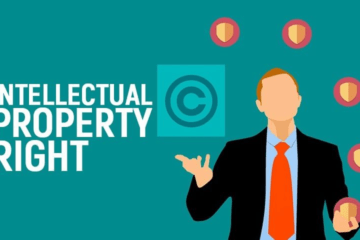
Written by – Ananya Shri Singh BALLB (HONS) – 3rd year of Indore Institute of Law, Madhya Pradesh
ABSTRACT
The interest of an individual must be protected so that the original work is not exploited or used unauthoritative. Further, the protection of such original work is ensued through a mechanism provided to the brainchild of the work in the form of rights which is referred as intellectual property rights (IPR).
The intellectual property rights are not a new concept, the concept can be dated back to 500 BCE, when Greek state, Sybaris made it possible for its citizen to obtain patent, hence, we can eventually come to the point that only during the evolution of centuries the concept of intellectual property laws came into the picture and hence evolved.
The roots of these rights find their way in Europe itself and the patents era came in the 14th century. The first declared copyrights came in Venice, Italy. Hence the laws and protection of these rights were emphasised to foster creativeness of the inventor of the work and ensure its beneficial use.
The intellectual property rights in today’s era occur two dimensionally which implies that these rights related to inventions are protected at national as well as international level. Various Treaties, Agreement and other Conventions make it necessary for the nation states to provide a mechanism devoid of any complexity to protect such work and recognise the original work, must ensure that there is no infringement of such rights as they impact the economic growth of the nation or society as whole.
- INTRODUCTION
Intellectual property rights are somewhat defined as the rights which a person hold in intangible ways or basically it refers to the rights over the ideas or inventions that are created by an individual in his own mental capacity.
The United Nation Declaration of Human Rights has also emphasised on the idea of intellectual property through the declaration given in Article 27. Which says that a person has the right to protect his ideas or any such material or immaterial interest that may arise out of his creativeness of the mind.
The purpose of intellectual property rights and their protection is only to recognise the creativeness of an individual and hence to give appraisal to his innovative skills of the thinking warehouse of the human body.
In this article the author has intended to decode the concept of intellectual property rights and its protection in worldwide as well as in Indian regime in best way possible. Here the emphasis will be on the protection aspect of this right.
- MEANING OF INTELLECTUAL PROPERTY RIGHTS.
Every individual is born with this natural instinct of dis-satisfaction. This imbibed dissatisfaction is the result of our thinking process more specifically, lets dive into this scope. Take for instance you are born on this planet but as soon as you grew up you see that few things are not present or maybe you think of a material object that would make you accomplish your task in more proper, organised, and easy way. Therefore, this imbibed nature in ourselves of developing our surrounding has led to the concept of idea or vision which give effect to the production or invention of new things.
Therefore, basically the conclusion that can be drawn from the above description of an illustration would be that any idea be it of artistic, literary or scientific or any particular sort of temper that creates an image of the innovation in our intellect are to be considered under the ambit of intellectual property and along with that their protection is equally important so that the other person who might be interested could not take the credit for the evolution of such an innovative idea.
- ADVANTAGES OF INTELLECTUAL PROPERTY RIGHTS.
Protection over competition business – with the help of intellectual property right there is room of protection to the ideas, innovation and hence its related business in the market.
Unauthorised use of ideas – the intellectual property rights protect.
the unauthorised use of the ideas or intellect inventions. Hence there is protection of one’s work.
The room for investment from various firms, company finds its way where the work is protected through the use of intellectual property rights into your company or and hence the productivity of the country as well as of the company is ensured through intellectual property rights.
Also, these rights open doors for making your work as a brand and hence the consumers identify your idea as a brand, it thus gives impetus to your company development as well as recognising your creation as a particular brand in the market.
- NEED FOR INTELLECTUAL PROPERTY RIGHTS.
Open rooms for inventions – these rights protect the idea and hence it avoids its exploitation. The work which is protected is used in an efficient manner. Fair trading – there is no copying of any work and hence these rights ensure smooth trading activities in the market. Promote creativity – through the incorporation and use of these rights an individual can make best use of his thinking process and intellect, thereby inventing and creating new material works. Through these the creativeness of an individual mind increases and develops.
Prevents the third party from taking the credit of some other who is involved in the idea or who is the brainchild of such creative work. Hence it protects the credit of the creator of the work or product. The intellectual property rights protect infringement of the proprietary rights of an individual and hence minimises if not eradicate, any scope of exploitation.
- VARIOUS COMPONENTS OF INTELLECTUAL PROPERTY RIGHTS.
- Copyright – this means that exclusive proprietary rights are given to the creator at the very initial stage when the work is published. This prevents the copying of the contents and its unauthorised usages. Copyrights Act, 1957 is a legislation that deals with Indian copyrights regime.
- Patents – this type of rights extend to the person who has invented work pertaining to commercial and industrial nature or value. Here the third parties are debarred from manufacturing, distributing, or selling objects without the permission of the owner of the patent. Patents Act, 1970 is the legislation.
- Trademarks and service marks. – the trademarks are basically that are associated with a particular work, this ensures differentiation of a particular goods of other enterprises. The symbols, figures, names are the trademark. Service marks are the trademarks associated with various services such as tourism, banking etc.
- Geographical indications – there are various resources that belongs to a particular geographical areas or area, hence in order to identify such resources geographical indications are used to identify goods. These include the quality, reputation that may be attributed to certain areas. For example, tea from Darjeeling and Ooty and so on.
- Trade secrets – these are the intellectual property rights that are associated, or confidential information pertaining to a company or certain work and may include within its ambit the designs, futuristic plans, strategies pertaining to business activities and soon.
LAWS PROTECTING INTELLECTUAL PROPERTY RIGHTS IN INDIA
The Copyrights Protection Act, 1950
- As discussed earlier the purpose of copyright pertains to the protection of expression of ideas. Here the copyrights do not protect only the idea. Section 13 of the act provides that protection can be obtained for original work including various files including works related to drama, literature, music, and other art forms. This copyright also extends to computer programs. This exclusive right gives a person the authority can carry any particular activity meant under the ambit of such work.
- Section 17 of the Act clearly states that the first owner of the copyright would be the author or creator of that specific original work. With addition to this it is also stated that the original author can make a third party access to such work through a written agreement.
- The act mentions that copyright protection is conferred on the original author of works pertaining to dramas, arts or music shall extend to a period of 60 years in addition to the period during which he survives or simply lives.
- Section 57 of the Act provides special powers to the original creator here it has been incorporated that even after conferring the copyright of the work to the third person the original creator has the power to claim for the authorship of the work as well as for the damages if any modification or distortions have been done to the original work and also if the reputation of the creator effects.
The Trademarks act, 1999 (“Trademarks act”)
- The trademark is associated with the symbols, features and names of the company. The trademarks are the only protection through which we can distinguish an enterprise from the other in the market. The trademark is somewhat related to the branding of the work.
- The trademark application is not necessarily be filed for registration of the features or marks that are currently in use, but it also covers within its ambit and scope the marks that are intended to be used for futuristic plans.
- Through the Madrid protocol for trademark where it could be registered internationally first it needs to be registered in India, India is thus signatory to the protocol.
- The validity of the trademark registration initially extends for a period of 10 year, but it can perpetually be extended or renewed for successive period of 10 years.
The Patents Act, 1970
- Patents are the intellectual property rights that tend to protect the all-new inventions in the market. The activities of industrial and commercial nature are usually covered under the Patent. It intentionally secures the rights of the inventor in order to prevent their unauthorized use and exploitation of the original creation.
- A patent is conferred upon for a period of twenty years. Here the forms of work including art forms are not covered under the patents act.
- This act bestows certain rights over the inventor. Firstly, the selling, importing, distribution and manufacturing of a product cannot be carried without the prior consent of the original inventor. The patents can be obtained internationally or can be registered in various other countries as India is signatory to the patent cooperation treaty.
The Design Act, 2000
- Design had been defined under section 2(d) of the act as any feature, shape, pattern, configuration or parallel lines, forms of three dimensional or two dimensional applied to the articles.
- Once a design is registered by the controller general of patents, design or trademark the designs are provided for a protection of 10 years which may on filling of an application pertaining to extension can be conferred upon with such power for another 5 years.
The Geographical Indications of Goods (registration and protection) Act, 1999
- In India we find many resources which belong to various geographical area, focuses on the place where they have their origin. For instance, Kola Puri chappals, Mahbubani paintings, Basmati rice and Darjeeling tea and so on.
- The protection of such registered geographical resources extends for a period of 10 years with the opportunity that it is also subject to renewal as well as extend. And hence further a period of 10 years can be associated with its protection from unauthorised use.
- The GI tags are basically meant to preserve the quality, culture, natural supplants go that area and in order to distinguish arterial made products from naturally occurring product from certain specific areas within the territory.
INTERNATIONAL REGIME FOR PROTECTION OF INTELLECTUAL PROPERTY RIGHTS
With the rapid increase in the development of trade and commerce, other innovative ideas in the global sphere it becomes important to protect the original work, expression pertaining to certain ideas or creations so that they are not subject to unauthorised use and also to distinguish such creations from other works.
Laws that protect the intellectual property rights at International level
Berne Convention (1886) – According to this convention it was made necessary for every country at the global level to recognise the intellectual property of an individual.
TRIOS Agreement (1994) – Here, the nations signatory to this agreement should regulate the intellectual property rights, must ensure their proper protection, and provide remedies in case of their remedies.
World Intellectual Property Organization (WIPO) Copyright Treaty (1996) – This treaty focuses on the copyright infringement of the internet regime. Therefore, this treaty makes endeavour to protect the internet usage and its related creativeness.
CONCLUSION
The scope of intellectual property rights protects the interest of intellect of an individual and these are protected either by providing remedies to the person considered by taking the cases to be decided by the civil or administrative courts. The general obligation of the nation states signatory to various treaties, agreement in international sphere is to evolve a remedial as well as enforceable mechanism which ensures the protection of IPR over new creations or original work of the creator. It is also clearly mentioned that the mechanism must be fair and equitable in its process of protection or providing remedies, cost effective and noncomplex.





0 Comments